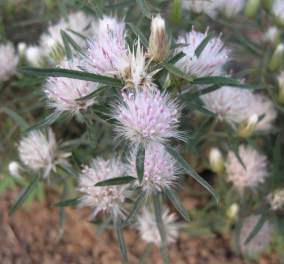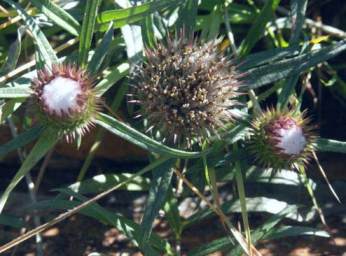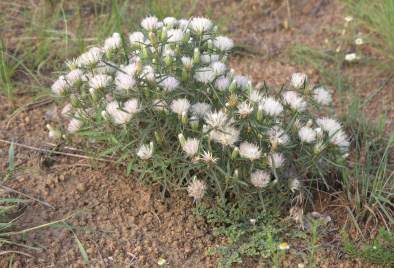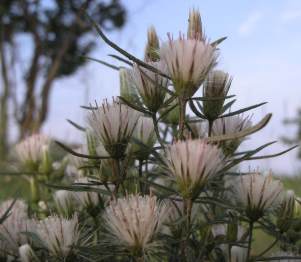Dicoma anomala
Dicoma anomala Sond.
Family: Asteraceae
Common names: fever bush, stomach bush (Eng.); maagbitterwortel, kalwerbossie, koorsbossie, gryshout, maagbossie (Afr.); hloenya, mohlasetse (South Sotho); inyongana (Swazi, Xhosa); isihlabamakhondlwane, umuna (Zulu)
Introduction
Dicoma anomala is a highly variable plant characterized by its stiff, sharp-pointed bracts, large flower heads and mauve-white florets surrounded by many white bristles.

Description
Description
Dicoma anomala is a prostrate, decumbent or erect perennial herb with an underground tuber. Few to many erect stems arise from a woody rootstock. Stems are thinly covered with hairs. Leaves are simple, alternate, stalkless, linear or narrowly lanceolate, the upper surface glabrous, the lower surface white-hairy. Flower heads are terminal, solitary or in small groups and have stiff, narrow, sharply-pointed bracts and slender, white, mauve, purple or pink tubular florets. The pappus consists of numerous barbellate bristles. Flowering occurs from November to July, with peak flowering in February and March.

Conservation Status
Status
Dicoma anomala is not threatened (Threatened Species Program, SANBI). However, the plant is widely utilized by people, who should be informed against over-utilization.
Distribution and habitat
Distribution description
Dicoma anomala is widely distributed in sub-Saharan Africa, resulting in pronounced morphological variation. It grows in the summer-rainfall areas and occurs in stony grasslands, hillsides or flat grassland and in savanna, on doleritic or sandy soils south of the Sahara, at altitudes ranging from 165 to 2 075 m.

In South Africa it is widely distributed in Limpopo, North-West, Gauteng, Mpumalanga, Free State, Northern Cape and KwaZulu-Natal. It does not occur in the winter-rainfall areas of the Western Cape. In KwaZulu-Natal it was mainly recorded from the Tugela Basin, on sandy soils.
Derivation of name and historical aspects
History
There are about 16 species of Dicoma in southern Africa. Dicoma tomentosa is the most widely distributed in Africa and D. anomala the second widest.
The genus name Dicoma was derived from the Greek words di meaning two, and kome meaning tuft of hair, referring to the double row of pappus bristles. The specific name anomala is Latin and means irregular or deviating from the normal.
Ecology
Ecology
Wind dispersal of seed probably takes place by means of the persistent barbellate pappus.
Uses
Use
With Afrikaans names such as koorsbossie (translated as fever bush) and maagbossie (stomach bush), it is not surprising that Dicoma anomala is used medicinally.
Root decoctions are administered orally or as enemas to children believed to be suffering from blood disorders. The root decoctions are used as a purgative for intestinal worms, colic, diarrhoea, dysentery, toothache, as an ingredient for sterilization medication and for haemorrhoids. The root decoctions are also mixed with plants called melkbos for fever, hence the Afrikaans name koorbossie.
Plant parts of Dicoma anomala are said to be used for coughs and respiratory complaints. Roots are sometimes chewed by the Xhosa to induce vomiting when there is suspicion that poisoned food has been ingested.
In animals, the root decoction is used for gall sickness, while powdered plants are used for sores and wounds.

Growing Dicoma anomala
Grow
Seeds should be sown in a sunny position in well-drained soil and watered regularly in summer (it grows in summer-rainfall habitats). The above-ground parts of the plant die down in winter and are therefore not affected by frost. Several plants should be grouped together. Seed should be sown in spring and should start germinating in 12-20 days. The seedlings transplant well and often flower at the end of the season. This plant grows well in any kind of soil.
References
- Eliovson, S.1980. Wild flowers of southern Africa : how to grow and identify them, edn 6. Macmillan, Johannesburg.
- Fabian, A. & Germishuizen, G. 1997. Wild flowers of northern South Africa. Fernwood Press, Vlaeberg, Cape Town.
- Germishuizen, G. & Meyer, N.L. 2003. Plants of southern Africa : an annotated checklist. Strelitzia 14. National Botanical Institute, Pretoria.
- Hilliard, O.M. 1997. Compositae in Natal. University of Natal Press, Pietermaritzburg.
- Hutchings, A., Scott, A.H., Lewis G. & Cunningham, A.B. 1996. Zulu medicinal plants: an inventory. University of Natal Press, Pietermaritzburg.
- Leistner, O.A. (ed.). 2000. Seeds plants of southern Africa : families and genera. Strelitzia 10. National Botanical Institute, Pretoria.
- Onderstall, J. 1996. Wild flower guide. Mpumalanga and Northern Province. DynamicAd, Nelspruit.
- Pooley, E. 1998. A field guide to wild flowers of KwaZulu-Natal and the Eastern Region. Natal Flora Publications Trust, Durban.
- Retief, E. & Herman, P.P.J. 1997. Plants of the northern provinces of South Africa : Keys and diagnostic characters. Strelitzia 6.National Botanical Institute, Pretoria.
- Van der Spuy, U. 1971. Wild flowers of South Africa for the garden. Hugh Keartland, Johanesburg.
- Watt, J.M. & Breyer-Brandwijk, M.G. 1962. The medicinal and poisonous plants of southern and eastern Africa, edn 2. Livingstone, London.
Credits
J. Mnengwane and M. Koekemoer
National Herbarium, Pretoria.
February 2007
Plant Attributes:
Plant Type: Perennial, Shrub
SA Distribution: Free State, Gauteng, KwaZulu-Natal, Limpopo, Mpumalanga, North West, Northern Cape
Soil type: Sandy, Clay, Loam
Flowering season: Late Summer, Autumn, Winter
PH:
Flower colour: Purple, White, Pink, Mauve/Lilac
Aspect: Full Sun
Gardening skill: Average
Special Features:
Horticultural zones






Rate this article
Article well written and informative
Rate this plant
Is this an interesting plant?
Login to add your Comment
Back to topNot registered yet? Click here to register.